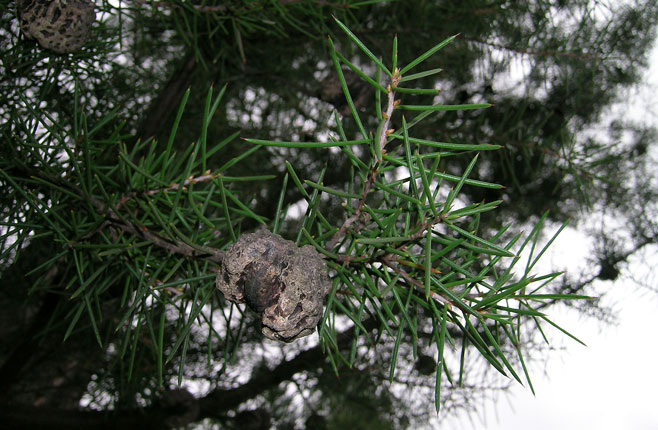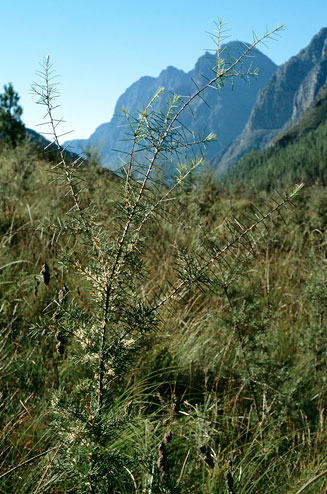Hakea sericea
(Needlebush, Silky hakea)
Life
> eukaryotes >
Archaeoplastida >
Chloroplastida
>
Charophyta > Streptophytina > Plantae (land plants)
> Tracheophyta (vascular plants) > Euphyllophyta > Lignophyta (woody plants)
> Spermatophyta (seed plants) > Angiospermae (flowering
plants) > Eudicotyledons > Order: Proteales
> Family: Proteaceae > Genus: Hakea
 |
|
Hakea sericea, Tsitsikamma National Park,
Eastern Cape, South Africa. [photo
H.G.
Robertson, Iziko ©] |
 |
 |
|
The invasive alien Hakea sericea flowering in
winter in fynbos in the Cape Peninsula mountains, Western Cape, South
Africa. [photo
Colin Paterson-Jones ©] |
The invasive alien Hakea sericea flowering
in fynbos in the Franschhoek Mountains, with a pine plantation and an
escaped pine tree beyond, Western Cape, South Africa. [photo
Colin Paterson-Jones ©] |
Hakea sericea is a woody shrub or small tree
that grows to 3-5 m in height. It is native to souteastern Australia
and invasive in fynbos regions of the Western and Eastern Cape in
South Africa.
Chronology of hakea control in South Africa
| Date |
Event |
| 1858 |
First record of Hakea sericea in the Cape, where it was recorded from
Cape Town. |
| 1863 |
Hakea sericea recorded from Bathurst in the
Eastern Cape where is was already well known. |
| 1938 |
Proclaimed a noxious weed in terms of the Weed Act. |
| 1960 |
Biological control of hakea proposed by F.J. Simmonds of
the Commonwealth Institute of Biological Control |
| Feb 1961 |
Conference on hakea held in Stellenbosch where an
interdisciplinary committee was formed to propose methods for controlling
this weed. Biological control was considered at the conference as a possible
control method. |
| Jul 1962 |
Biological control programme initiated for control of
hakea in South Africa: D. van V. Webb sent to Australia to investigate
insect species that feed on hakea and which might be suitable for
importation as biological control agents. |
| Dec 1968 |
A biological control laboratory is set up in
Stellenbosch. |
| 1969-1980 |
Stocks of biological control insects brought in from
Australia. |
| 1970-1971 |
First release of seed-feeding weevil Erytenna consputa
in Southwestern Cape. These particular weevils had been collected from
Wilson's Promontory in Australia and performed poorly, possibly because of
climatic reasons. |
| 1970 |
First releases of the moth Carposina autologa at
Wemmershoek in the Western Cape. |
| 1974-1981 |
About 8000 Erytenna consputa weevils imported from
Victoria and New South Wales. This weevil became established at a large
number of sites in the southwestern and southern Cape. |
| 1976 - 1979 |
19 376 ha of infested fynbos in the South-Western Cape
cleared of hakea using the 'fell-and-burn' method. |
| 1977 - 1983 |
More than 3000 Cydmaea binotata weevils imported
from Australia. |
| 1978 - 1982 |
Main period during which eggs of the moth Carposina
autologa were imported from Australia into South Africa for the
biocontrol of hakea. |
| 1980 - 1984 |
Cydmaea binotata weevils at over 36 sites in the
Western Cape and Eastern Cape but only became established at four sites. |
| 1983 |
480 000 ha infested in what is now known as the Western
Cape and Eastern Cape, South Africa, amounting to about 14% of the remaining
mountain fynbos. |
| 1983 -1986 |
Erytenna consputa weevils collected at established
sites and re-distributed to other areas thus increasing the spread of this
species. |
|
